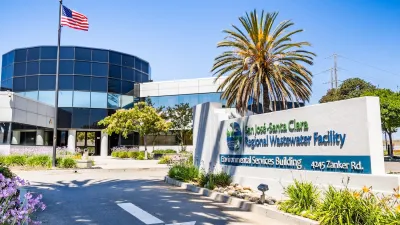Over a year ago I blogged about a conference of urban historians where the group debated a talk, titled "Whither the Region?," where historian Greg Hise observed the group was talking about regional history less. In my response, I suggested several causes: limited decision-making at the regional level in America, center city biases among historical sources like newspapers, and metropolitan areas growing to encompass entire regions due to urban sprawl. I also observed that although it may go unstudied by the group, a good number of regional planning organizations and agencies do exist.
Over a year ago I blogged about a conference of urban historians where the group debated a talk, titled "Whither the Region?," where historian Greg Hise observed the group was talking about regional history less. In my response, I suggested several causes: limited decision-making at the regional level in America, center city biases among historical sources like newspapers, and metropolitan areas growing to encompass entire regions due to urban sprawl. I also observed that although it may go unstudied by the group, a good number of regional planning organizations and agencies do exist.
Since last September, I've actually worked for one of the very regional agencies I described, Boston's Metropolitan Area Planning Council. Established under Massachusetts law in 1963, MAPC is one of 13 regional planning agencies in the state. In fact, under the umbrella category of regional councils (which can include a variety of types of organizations including councils of government (COGs) and metropolitan planning organizations (MPOs)) these groups practically blanket the country. This map, created by the National Association of Regional Councils, illustrates their extent:

Despite their impressive number, these organizations exist with little resources and few formal powers. All the while, their counterparts at the local and national levels are experiencing a renaissance.
At the local level, decades of work mean many of the smallest towns sport downtown business improvement districts, historic districts, sophisticated mixed-use zoning, and even form-based codes. Local planners engage in innovative methods at citizen engagement and many are posting rich collections of plans and information online. The results are an ideological sophistication and community engagement missing from much of planning in the 20th century.
Combined with these changes in the practice of planning is an epochal shift in American urban growth. Driven by changing demographics, lifestyles, preferences, and energy costs, cities are seeing unprecedented growth at the core, and dozens are investing in urban transportation at a scale unthinkable twenty years ago. In cities and towns across the country, these shifts mean investment and collective attention are returning to long-overlooked towns and urban neighborhoods.
At the same time as this local action, the federal government has returned to the realm of urban development with vigor. President Obama declared flatly the era of sprawl is over, and his administration has a more urban orientation than any since perhaps Johnson. He promises to coordinate the myriad federal agencies through a new office of urban policy. The American Recovery and Reinvestment Act contains billions for urban infrastructure and even funds to develop high speed intercity passenger rail. With Congress already discussing a radically different approach to the new transportation bill, I argued in a recent post that together these developments could result in a new era of national planning.
Meanwhile, regional planning remains anemic. To my knowledge, states that created regional planning organizations in the 1960s (like Massachusetts) have not substantially revised the boundaries, powers, or funding sources of these organizations since then. Metropolitan planning organizations, many created in their current form when they were first required by the federal government in the 1970s for transportation planning purposes, have seen modest growth in responsibilities and funding but are overshadowed in relevance by the federal government, state highway departments, or even the municipalities within their jurisdictions.
In fact, Americans seem more comfortable with government power exercised at the local level and at a very large-scale state or federal level than anything in between. I think one of the causes for this dichotomy may be that our political system has no good models for regional governance, therefore citizens have the understandable fear of giving power to regional entities outside of their control. Portland, Oregon has attempted to address this by creating a regional council comprised of directly elected officials. Although interesting, I'm not sure adopting a similar approach nationwide would solve our problems, only create a new layer of government.
Although a provocative idea, David Rusk's proposal to expand city boundaries to include suburbs is not realistic. Local identiy and political power in American is tightly held, and I'm amazed by the extent to which portions of Boston annexed in the 1860s and 1870s retain their identities. A more realistic model exists outside of Washington, D.C. in Maryland's Montgomery and Prince George's Counties. Recognizing that the nation's capital would grow out into these regions, in the 1930s the state government gave the two counties urban planning powers. Cities were allowed to incorporate within the counties, only generally with limited land use planning powers. Nonetheless even this model is not ideal, as growth has leapfrogged Montgomery County's careful growth management plans to spill into West Virginia, and the two counties are a minor portion of the entire metropolitan area.
Does regional planning have a future in the U.S., or are we destined for a future where our jealously independent towns and cities will develop in an uncoordinated way? Should the existing regional planning agencies and MPOs be reformed? Or is the concept of regional planning itself simply too foreign to American political culture?

Planetizen Federal Action Tracker
A weekly monitor of how Trump’s orders and actions are impacting planners and planning in America.

Maui's Vacation Rental Debate Turns Ugly
Verbal attacks, misinformation campaigns and fistfights plague a high-stakes debate to convert thousands of vacation rentals into long-term housing.

San Francisco Suspends Traffic Calming Amidst Record Deaths
Citing “a challenging fiscal landscape,” the city will cease the program on the heels of 42 traffic deaths, including 24 pedestrians.

Amtrak Rolls Out New Orleans to Alabama “Mardi Gras” Train
The new service will operate morning and evening departures between Mobile and New Orleans.

The Subversive Car-Free Guide to Trump's Great American Road Trip
Car-free ways to access Chicagoland’s best tourist attractions.

San Antonio and Austin are Fusing Into one Massive Megaregion
The region spanning the two central Texas cities is growing fast, posing challenges for local infrastructure and water supplies.
Urban Design for Planners 1: Software Tools
This six-course series explores essential urban design concepts using open source software and equips planners with the tools they need to participate fully in the urban design process.
Planning for Universal Design
Learn the tools for implementing Universal Design in planning regulations.
Heyer Gruel & Associates PA
JM Goldson LLC
Custer County Colorado
City of Camden Redevelopment Agency
City of Astoria
Transportation Research & Education Center (TREC) at Portland State University
Jefferson Parish Government
Camden Redevelopment Agency
City of Claremont






























